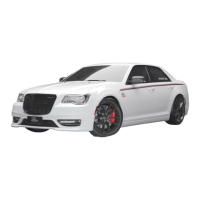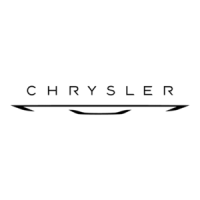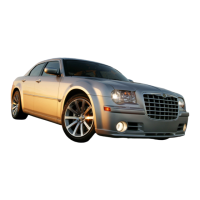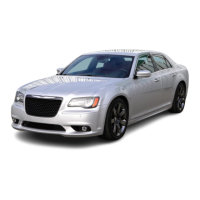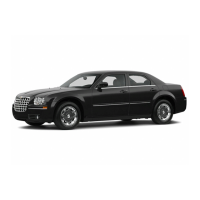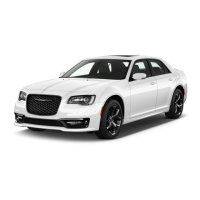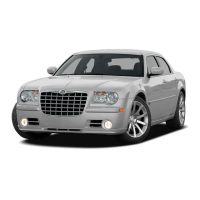
Do you have a question about the Chrysler 300 SRT8 and is the answer not in the manual?
| Brand | Chrysler |
|---|---|
| Model | 300 SRT8 |
| Category | Automobile |
| Language | English |
Overview of the owner's manual and its purpose.
Guidance on navigating the manual using the table of contents and index.
Information on safety warnings and cautions within the manual.
Location and importance of the VIN.
Warning about modifications and their impact on safety.
Details on the key fob, ignition node, and starting procedures.
Information on the security alarm and immobilizer systems.
Operation of manual and power door locks, and passive entry systems.
Operation of power windows and sunroof features.
How to lock, release, and use the trunk emergency release.
Information on seat belts, pretensioners, and child restraints.
Overview of controls and features on the instrument panel.
Explanation of various indicator lights and gauges in the instrument cluster.
How to use the EVIC for system status, warnings, and settings.
How to view and calibrate the compass and set variance.
How to control the navigation display using steering wheel buttons.
How to select and adjust surround sound modes.
Understanding various messages displayed by the EVIC.
Customizing vehicle features like door locks, lights, and wipers.
How to set the vehicle's analog clock.
Basic radio functions including power, volume, tuning, and presets.
How to play CDs, MP3s, and WMAs, including disc compatibility.
Connecting and controlling iPod/iPhone devices via the vehicle's system.
Features of the Kicker high-performance audio system with DSS.
Operation of the rear seat video entertainment system.
Using steering wheel controls for the audio system.
Operation of automatic temperature control and manual settings.
Tips for summer and winter operation, and managing window fogging.
General steps for starting the vehicle safely.
How to use the automatic transmission and shift lever.
Operating the ignition with the push-button start system.
Steps for starting the engine using the start/stop button or key fob.
Procedures for starting the engine in very cold temperatures.
Troubleshooting steps if the engine does not start, including clearing a flooded engine.
How to use the engine block heater for cold weather starting.
Precautions and advice for driving on snow, ice, or wet surfaces.
How to safely drive through shallow or flowing water.
Information on the power steering system and fluid checks.
How to apply and release the parking brake correctly.
Overview of the hydraulic brake system, ABS, TCS, BAS, and ESP.
Information on tire markings, including DOT codes, size, and service descriptions.
Information on tire load capacity and inflation pressures from the placard.
How the TPMS warns of low tire pressure and system malfunctions.
Information on gasoline octane, reformulated fuel, and oxygenate blends.
Precautions for using gasoline and avoiding fuel system damage.
Safety precautions to prevent carbon monoxide poisoning.
How to properly add fuel and use the fuel filler cap.
Information found on the vehicle certification label.
Guidelines for loading the vehicle and avoiding overloading.
Recommendations and limitations regarding trailer towing.
How to activate and use the hazard warning flashers in an emergency.
Steps to take if the engine overheats, including precautions and CAUTIONS.
Information about the TIREFIT system for tire repair.
Step-by-step instructions for using the TIREFIT kit to seal a tire.
Detailed steps for safely jump-starting the vehicle's battery.
Methods for rocking the vehicle out of mud, sand, or snow.
Procedures for towing the vehicle with or without the ignition key, and with a tow dolly.
Identification of key components in the engine compartment.
How the OBD II system monitors vehicle performance and emissions.
Information on emissions testing requirements and vehicle readiness.
Recommendations for using genuine MOPAR parts for maintenance.
Benefits of using authorized dealers for service and expertise.
Overview of required maintenance services and intervals.
How to check engine oil level, change oil, and select the correct oil type.
When to replace the engine oil filter and selection criteria.
Maintenance and selection of the engine air cleaner filter.
Information about the maintenance-free battery and its location.
Recommended service for the air conditioning system.
Location and replacement of the A/C air filter.
Lubrication points for body pivots, locks, and hinges.
Cleaning and maintenance of wiper blades.
Checking and refilling windshield washer fluid.
Importance of a well-maintained exhaust system for safety and emissions.
Checking and maintaining the engine coolant and pressure cap.
Steps for draining, flushing, and refilling the cooling system.
How to add coolant, including mixture ratios and types.
Safety precautions for handling the cooling system pressure cap.
How to check and maintain the engine coolant level.
Overview of the hydraulic brake system, components, and performance.
How to check and maintain the brake fluid level.
Information on checking and changing automatic transmission fluid.
Procedures for changing transmission fluid and filter.
How to protect the vehicle's body and paint from corrosion.
How to wash the vehicle and special care instructions.
Cleaning fabric, carpet, vinyl, and leather upholstery.
Procedures for cleaning headlights, glass surfaces, and instrument cluster lenses.
How to clean and maintain seat belts.
Information on fuses, relays, and the integrated power module.
Location and contents (fuses and relays) of the rear power distribution center.
Steps to take when storing the vehicle for extended periods.
List of interior and exterior bulb types and their numbers.
Procedures for replacing headlight bulbs, including HID warnings.
How to replace tail, stop, turn signal, and backup light bulbs.
How to replace the license plate light bulb.
Maintenance requirements for the emissions control system.
Overview of scheduled maintenance services and intervals.
How the oil change indicator system works and how to reset it.
Detailed list of maintenance tasks at various mileage and time intervals.
Routine checks to be performed once a month.
Tips for preparing for service appointments and discussing issues with advisors.
Information on contacting the manufacturer or dealer for assistance and resolving issues.
Contact information for hearing or speech impaired customers.
Information about purchased service contracts and warranty coverage.
Details on the terms and provisions of Chrysler Motors LLC warranties for U.S. vehicles.
Availability of genuine MOPAR parts and accessories from authorized dealers.
How to report potential safety defects to NHTSA and the manufacturer.
How to order service manuals and other publications.
Explanation of DOT uniform tire quality grading categories.
Understanding the treadwear grade and its relation to tire performance.
Understanding tire traction grades and their meaning for stopping on wet pavement.
Understanding tire temperature grades and their relation to heat resistance.
